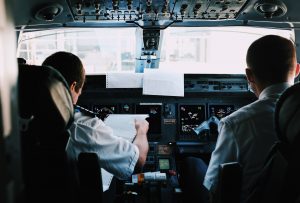When you think of your future, do you look to the sky? When you hear an airplane engine, do you look skyward to spot that airplane and follow it as it flies overhead, imagining yourself as the pilot in command? For many, the dream of flying becomes a reality and quickly becomes a part of who you are. So it is for those whom join the ranks of commercial pilots.
Much has been reported lately regarding our country’s emerging pilot shortage. This is occurring for many reasons, including the industry-changing airline deregulation of the late 70’s, increasing consumer/traveler demand, fewer pilots transitioning from military careers, and higher hour requirements, known as the 1,500 hour rule, which is required to become a commercial pilot.
However, pilots today come from many walks of life and take many different paths. Some go to their local flight schools, others go to colleges with aviation programs and others pursue military flying careers. After obtaining their licenses, many build their hours over time as instructors or other flying jobs, such as news and traffic reporting to build up to the 1,500 hours necessary for the Air Transport Pilot (ATP) certificate.
Many dream of someday taking to the sky, but many also are dissuaded for a variety of reasons. Costs of training are an understandable obstacle for many. For those individuals, there are flight school scholarships, scholarship programs from private organizations and associations, such as the Aircraft Owners and Pilots Association, the Experimental Aircraft Association, not to mention, the wonderful aerospace opportunities afforded by the Civil Air Patrol’s cadet programs.
There is no need or expectation to be a modern-day “Top Gun,” but there are basic skills necessary for safe operation of aircraft. Future pilots should have solid decision-making and problem-solving skills, motor coordination, as well as strong memory and processing speed. It’s also important to have good interpersonal skills, such as an ability to get along with others and work as part of a team.
All pilots must hold a medical certificate in addition to a pilot’s license. Medical certification may require the need for examination, such as a history of Attention Deficit Hyperactivity Disorder, learning issues in school or other pre-existing conditions. While in the past, many conditions were considered “disqualifying,” the FAA is constantly exploring pathways to evaluate prospective pilots to ensure their ability to safely operate aircraft.
For these special situations, it’s important to seek the assistance of experienced clinicians familiar with the relevant federal regulations. More importantly, the clinician should be very familiar with the aeromedical significance and relevance of the findings. It’s also very helpful when a clinician knows how to address certain areas of concern. If the desire to fly leads an applicant down the path of needing a specialized neuropsychological assessment, there is no substitute for experience or access to a specialized consultation.
So for those who have been discouraged from pursuing your dream to be a pilot, there may, in fact, be a pathway to the sky. First, consult with a local flight school and go for an orientation flight. Then, consult with an FAA-designated Aviation Medical Examiner, and if necessary, seek out the required evaluations by a licensed psychologist. Your dream may not be as far off as you think!
Blue skies and tailwinds!







